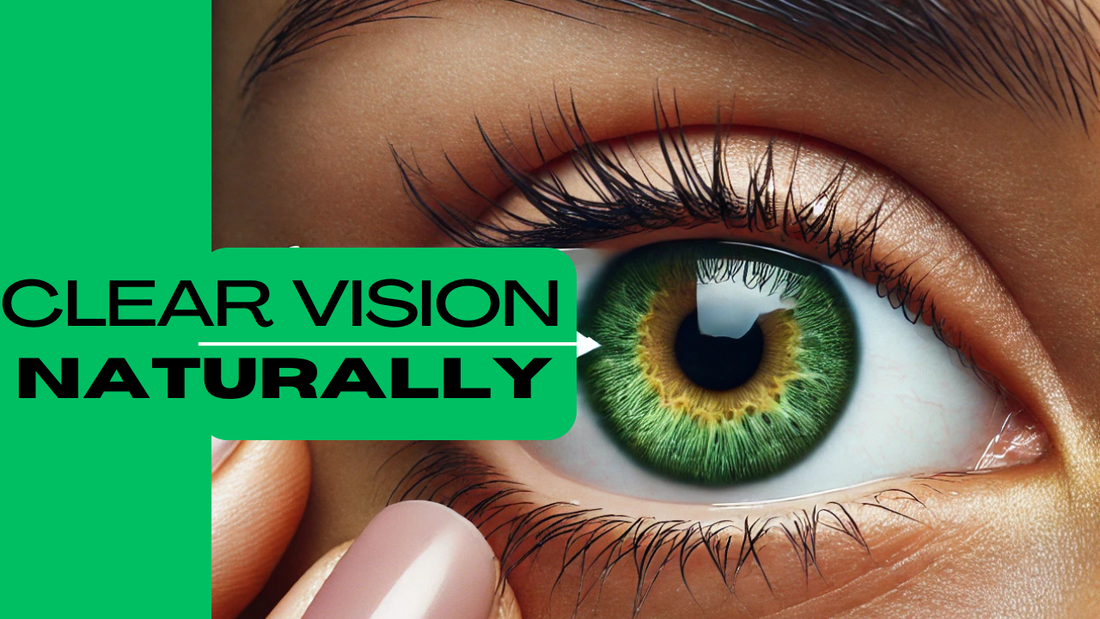
Entendiendo las manchas algodonosas: Causas, tratamientos y opciones naturales
Compartir
Las manchas algodonosas, aunque pequeñas en apariencia, pueden ser indicadores importantes de afecciones subyacentes. Estas manchas blancas y esponjosas en la retina no constituyen una enfermedad en sí mismas, sino una señal de advertencia de daño microvascular y falta de oxígeno en las fibras nerviosas retinianas. Si bien suelen ser asintomáticas, pueden ser una señal crítica de enfermedades y afecciones sistémicas que requieren atención inmediata. Esta entrada del blog explorará los mecanismos que subyacen a las manchas algodonosas, sus causas, los tratamientos disponibles y los remedios naturales para mantener la salud de la retina.
¿Qué son las manchas de algodón?
Las manchas algodonosas son esencialmente microinfartos de la retina causados por la interrupción del flujo sanguíneo a las fibras nerviosas. Cuando las fibras nerviosas retinianas carecen de suficiente oxígeno (isquemia), el material axoplásmico se acumula, formando estas distintivas manchas blancas y esponjosas, visibles durante un examen ocular. Aunque las manchas algodonosas en sí mismas no son dañinas, suelen indicar afecciones vasculares o sistémicas subyacentes que pueden ser graves si no se tratan.
Pueden aparecer como placas solitarias o en grupos y suelen resolverse en cuestión de semanas o meses, dependiendo del tratamiento de la afección subyacente. Sin embargo, su presencia suele justificar una evaluación más profunda del estado de salud del paciente.
¿Cómo se forman las manchas de algodón?
La retina depende de un suministro constante de oxígeno y nutrientes proveniente de los vasos sanguíneos que la recorren y la rodean. Cuando este suministro de sangre se interrumpe, las fibras nerviosas de la retina no pueden funcionar correctamente, lo que provoca la formación de manchas algodonosas. La siguiente secuencia describe su formación:
- Bloqueo microvascular: un bloqueo en los capilares de la retina interrumpe el flujo de oxígeno y nutrientes.
- Isquemia: la falta de oxígeno provoca daño celular y disfunción en las fibras nerviosas de la retina afectadas.
- Acumulación axoplásmica: se altera el transporte de material celular dentro de las fibras nerviosas, lo que provoca una acumulación de material axoplásmico, que se manifiesta como manchas de algodón.
- Curación o progresión: Si se aborda la causa subyacente, las manchas algodonosas pueden desaparecer. De lo contrario, pueden persistir o empeorar, lo que podría provocar complicaciones retinianas o sistémicas más graves.
Causas comunes de las manchas de algodón
Las manchas algodonosas pueden deberse a diversas afecciones sistémicas y oculares. Estas son las causas más comunes:
1. Diabetes (retinopatía diabética)
La diabetes es una de las principales causas de las manchas algodonosas. Los niveles altos de azúcar en sangre dañan los pequeños vasos sanguíneos de la retina, lo que provoca fugas, mala circulación e isquemia.
2. Hipertensión (presión arterial alta)
La hipertensión arterial no controlada daña los vasos sanguíneos de la retina, lo que provoca una reducción del flujo sanguíneo y la formación de manchas algodonosas. La hipertensión crónica puede provocar retinopatía hipertensiva, donde estas manchas son comunes.
3. Oclusión de la vena retiniana
Una obstrucción en las venas retinianas puede impedir el flujo sanguíneo adecuado, lo que provoca isquemia y la aparición de manchas algodonosas. La oclusión de las venas retinianas suele asociarse con afecciones vasculares sistémicas.
4. Enfermedades e infecciones autoinmunes
Afecciones como el lupus, el VIH/SIDA y la arteritis temporal pueden causar inflamación o daño a los vasos sanguíneos, lo que provoca la aparición de manchas algodonosas. Infecciones graves, como la sepsis o la endocarditis, también pueden contribuir.
5. Enfermedad de la arteria carótida
Los bloqueos o estrechamientos de las arterias carótidas pueden reducir el flujo sanguíneo a los ojos, provocando manchas algodonosas como señal de advertencia de mala circulación sistémica.
6. Retinopatía por radiación
Los pacientes sometidos a radioterapia cerca de los ojos pueden experimentar daños en los vasos sanguíneos de la retina, lo que produce manchas algodonosas.
7. Trastornos de la sangre
Afecciones como la anemia, la leucemia o la trombocitopenia pueden afectar el suministro de oxígeno a la retina y provocar manchas algodonosas.
Síntomas de las manchas de algodón
En muchos casos, las manchas algodonosas son asintomáticas y solo se detectan durante un examen ocular de rutina. Sin embargo, en casos más graves o si son numerosas, los síntomas pueden incluir:
- Visión borrosa: especialmente si las manchas están cerca de la mácula (área de visión central).
- Puntos ciegos (escotomas): áreas localizadas de pérdida de visión.
- Moscas volantes: En raras ocasiones pueden notarse manchas en el campo visual.
- Visión distorsionada: si las manchas interfieren con la luz que llega a la retina.
Tratamientos convencionales para las manchas algodonosas
El tratamiento de las espinillas algodonosas se centra principalmente en abordar la afección subyacente. Dado que son un síntoma y no una enfermedad aislada, es fundamental abordar su causa raíz.
1. Tratamiento de enfermedades sistémicas
- Control de la diabetes: mantener niveles estables de azúcar en sangre mediante dieta, ejercicio y medicamentos puede prevenir mayores daños a la retina.
- Control de la presión arterial: controlar la hipertensión con cambios en el estilo de vida y medicamentos puede reducir el riesgo de retinopatía hipertensiva.
- Control del colesterol: Los niveles altos de colesterol pueden exacerbar los problemas vasculares, por lo que se puede recetar una dieta para reducir los lípidos o estatinas.
2. Monitoreo y seguimiento
Los exámenes oculares regulares y las imágenes (por ejemplo, fotografía del fondo del ojo o tomografía de coherencia óptica) son fundamentales para monitorear la progresión de las manchas algodonosas y garantizar que las afecciones subyacentes se estén tratando de manera eficaz.
3. Terapias de retina
En casos graves, en particular aquellos que implican oclusión de la vena retiniana, pueden ser necesarios tratamientos como inyecciones anti-VEGF o fotocoagulación láser para mejorar el flujo sanguíneo retiniano y reducir la isquemia.
Remedios naturales y de apoyo
Si bien la medicina convencional aborda las causas sistémicas de las manchas algodonosas, ciertos enfoques naturales pueden complementar estos tratamientos y favorecer la salud ocular y vascular general.
1. Apoyo dietético
Una dieta rica en antioxidantes y nutrientes puede promover la salud de la retina y mejorar la función vascular:
- Luteína y zeaxantina: presentes en las espinacas, la col rizada y los huevos, estos carotenoides protegen la retina del estrés oxidativo.
- Ácidos grasos omega-3: presentes en el pescado, las semillas de lino y las nueces, los omega-3 favorecen la salud de los vasos sanguíneos y reducen la inflamación.
- Vitamina C y E: Antioxidantes que reducen el estrés oxidativo y mejoran el flujo sanguíneo.
- Bayas oscuras (arándanos, arándanos azules): son ricas en antocianinas, que mejoran la circulación retiniana.
- Magnesio: Ayuda a relajar los vasos sanguíneos y mejorar el flujo sanguíneo.
2. Remedios herbales
Varias hierbas pueden favorecer la salud vascular y de la retina:
- Ginkgo Biloba: Mejora la microcirculación en la retina y puede reducir el daño isquémico.
- Cúrcuma (curcumina): sus propiedades antiinflamatorias y antioxidantes pueden proteger los vasos sanguíneos.
- Extracto de arándano: tradicionalmente utilizado para mejorar la visión nocturna y mejorar la salud de la retina.
3. Cambios en el estilo de vida
- Ejercicio: La actividad física regular mejora la circulación y reduce los factores de riesgo sistémicos como la hipertensión y la diabetes.
- Manejo del estrés: el estrés crónico puede elevar la presión arterial y empeorar la salud vascular.
- Dejar de fumar: fumar daña los vasos sanguíneos y agrava la isquemia retiniana.
- Hidratación: Una hidratación adecuada favorece el flujo sanguíneo y el suministro de oxígeno a los tejidos.
4. Suplementos para la salud ocular
- Coenzima Q10 (CoQ10): Apoya la función mitocondrial en las células de la retina.
- Vitaminas B (B12, B6, folato): ayudan a reducir los niveles de homocisteína, que pueden dañar los vasos sanguíneos.
- Ácido alfa lipoico: un potente antioxidante que protege contra el estrés oxidativo.
- Zinc: esencial para la salud de la retina y el apoyo inmunológico.
5. Proteger los ojos de daños mayores
- Gafas de sol con bloqueo UV: protegen los ojos de los dañinos rayos ultravioleta.
- Limite el tiempo frente a la pantalla: reduce la fatiga visual y preserva la salud ocular general.
Cuándo consultar a un médico
Las manchas algodonosas no son una afección que se pueda ignorar. Si experimenta alguno de los siguientes síntomas, busque atención médica de inmediato:
- Pérdida repentina de la visión o visión borrosa.
- Aumento de puntos ciegos o dificultad para ver.
- Signos de enfermedades sistémicas como diabetes o hipertensión no controladas.
- Los síntomas de un accidente cerebrovascular (por ejemplo, debilidad, dificultad para hablar), como manchas algodonosas, a veces pueden indicar una mala circulación sistémica.
Conclusión
Las manchas algodonosas pueden parecer benignas a primera vista, pero a menudo son un indicio de problemas de salud sistémicos que requieren atención. Al comprender cómo se forman, controlar sus causas subyacentes e incorporar remedios naturales para apoyar la salud vascular y retiniana, los pacientes pueden prevenir complicaciones posteriores y mantener una mejor salud general. Si sospecha que tiene manchas algodonosas o experimenta algún cambio en la visión, consulte a su oftalmólogo de inmediato para abordar la causa raíz y proteger su visión en el futuro.
